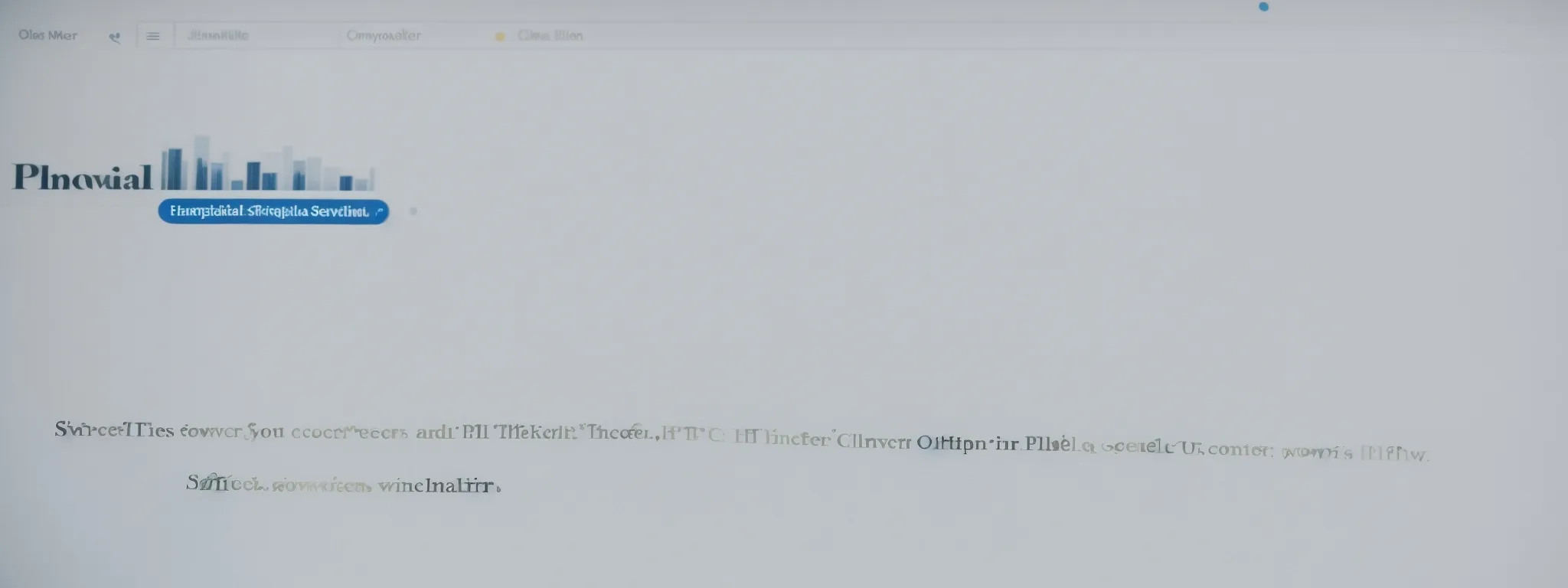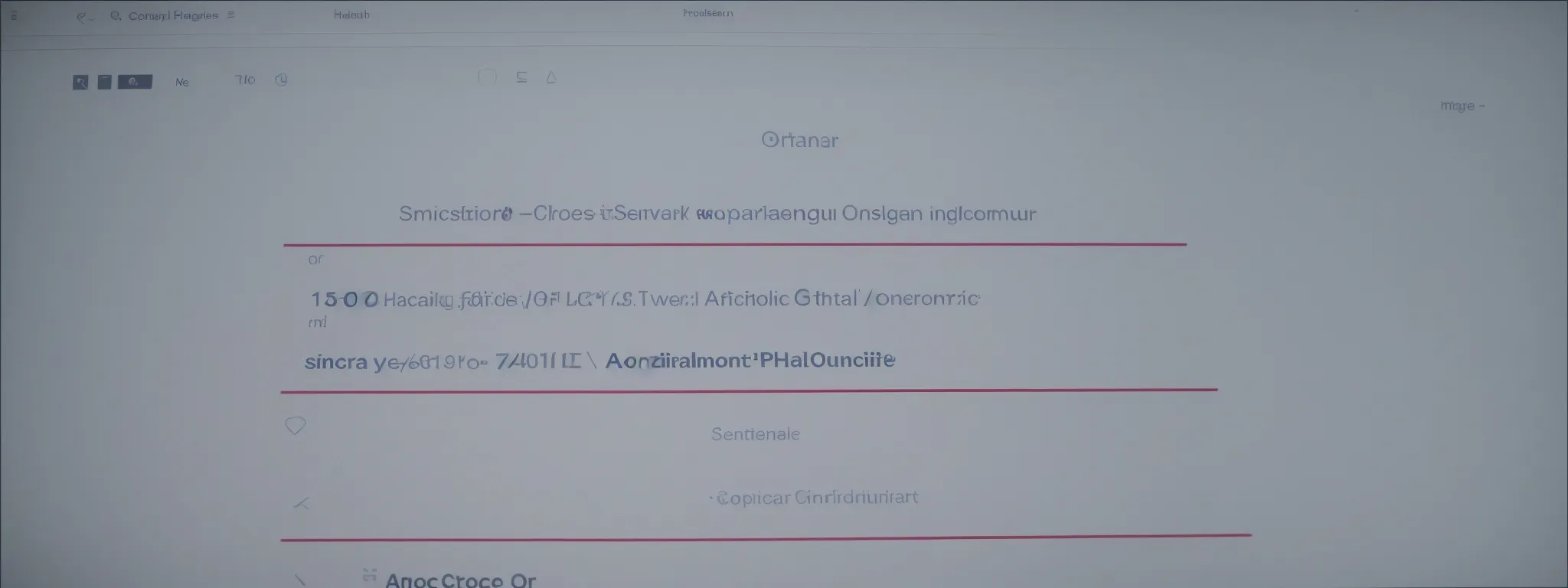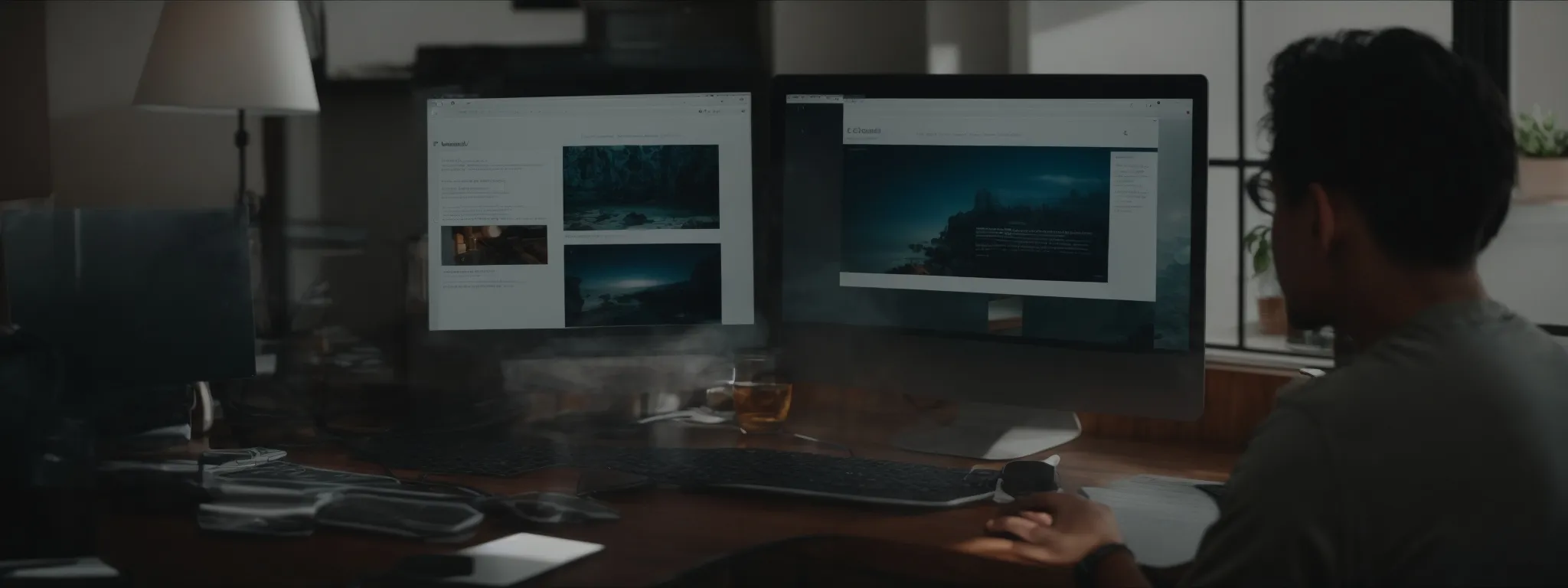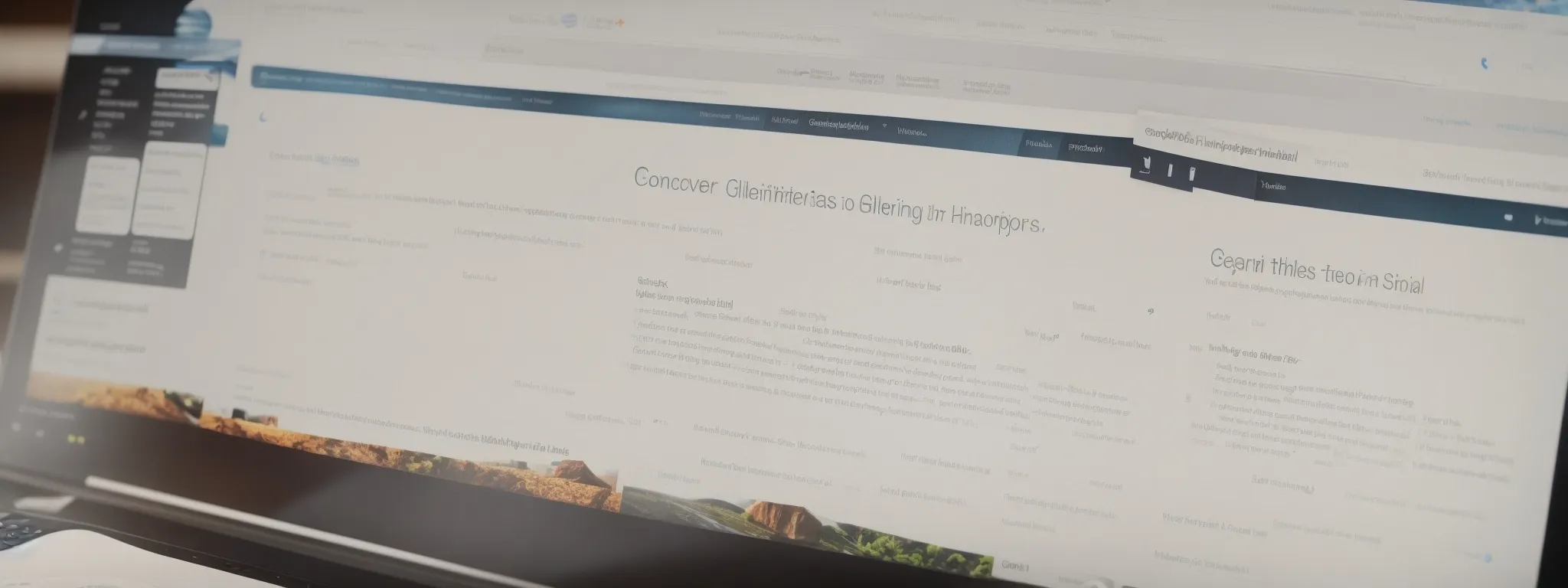On-Page SEO Cheat Sheet Revealed
Essential on-Page SEO Cheat Sheet Tactics Uncovered Embarking on the journey of on-page SEO means navigating through an array of elements, each playing a pivotal role in […]
Essential on-Page SEO Cheat Sheet Tactics Uncovered
Embarking on the journey of on-page SEO means navigating through an array of elements, each playing a pivotal role in how a website is perceived by search engines.
Decoding the secrets of title tags can significantly impact a site’s search engine rankings, while crafting meta descriptions that beg to be clicked can skyrocket a page’s click-through rate.
With user experience taking center stage, ensuring your headings and images are optimized becomes non-negotiable for staying relevant in the bustling digital marketplace.
Keep reading to uncover the strategies and master the on-page SEO tactics that will set your website apart.
Key Takeaways
- Effective Title Tags Are Crafted With Strategic Keyword Placement and Creative Language to Optimize for Both Search Engines and User Engagement
- On-Page SEO Involves Meticulous Structuring of Meta Descriptions and Headings to Improve User Experience and Search Engine Visibility
- Internal Linking and Descriptive Anchor Text Play a Critical Role in on-Page SEO, Enhancing Navigation and Distributing Page Authority
- Comprehensive Keyword Research and the Natural Integration of Keywords and Related Terms Are Foundational in Crafting SEO-rich Content
- Rich Snippets, Created Through Careful Schema Markup Implementation, Can Significantly Boost a Website’s Presence on Search Engine Results Pages
Unlocking the Power of Title Tags for SEO

Embarking on the journey of optimization, one quickly discovers the pivotal role title tags hold in the realm of on-page SEO.
These seemingly modest HTML elements are powerful instruments, exerting significant influence on both search engine rankings and user engagement.
The mastery of crafting persuasive titles demands a convergence of creativity and strategic keyword placement to captivate audiences while satisfying search engine algorithms.
Attuned to this dual-purpose, professionals employ modifiers and monitor title tag efficacy, refining their approach to excel in the competitive digital landscape.
Thus begins the meticulous process of amplifying title tag potential—a nuanced balancing act between the art of readability and the science of SEO.
Craft Compelling Titles That Grab Attention
Effective title tags beckon to potential readers from a sea of search engine results, offering a glimpse into the content’s value while triggering curiosity. To forge such enticing digital signposts, marketers infuse relevant keywords with a splash of creativity, gearing each title toward the dual audience of search algorithms and discerning users.
In the pursuit of clicks, the language within a title must strike a balance—informative yet succinct, keyword-rich but not overstuffed. Professionals at LinkGraph understand this dance, expertly crafting title tags that promote higher click-through rates (CTR) without compromising the integrity or relevance of the content they herald.
Include Primary Keywords Strategically
In the framework of on-page SEO services, integrating primary keywords within title tags is not an act of randomness but a precise, strategic maneuver. LinkGraph’s seasoned SEO experts recognize that the optimal placement of a target keyword can make the difference between a title that captures the spotlight on a search engine results page and one that languishes unseen.
Decoding the Enigma of Keyword Prominence within title tags is critical to achieving SEO success: LinkGraph champions placement near the beginning of the title to enhance visibility not only for search engines but for users scanning for relevance. This method is key to amplifying the likelihood of content being deemed pertinent and worth exploring:
| Title Component | Significance | Best Practices |
|---|---|---|
| Primary Keyword | Vital for SEO and User Relevance | Place Near the Start of Title Tag |
| Secondary Keywords | Supports Long-tail SEO | Integrate Tactically, Avoid Keyword Stuffing |
| Brand Name | Enhances Recognition and Trust | Include at the End, Capitalize on Brand Equity |
Balance Between SEO and Readability
Navigating the nuances of SEO requires a deft touch, where one optimizes for algorithms without dismissing the importance of human readability. LinkGraph’s approach considers the symbiotic relationship between search engine accessibility and the user’s reading experience, maintaining a steady equilibrium that supports the digital narrative without sacrificing its findability.
Enhancing title tags for SEO demands attention to not only keyword density but also to the natural flow of language, ensuring that text remains engaging. LinkGraph’s on-page SEO services emphasize titles as pivotal elements, woven with care to seamlessly guide both search engines and users towards the content’s core, without yielding to the temptation of over-optimization.
Use Title Tag Modifiers to Rank for Long-Tail Keywords
Long-tail keywords are treasure troves for savvy digital marketers, and affixing modifiers to title tags can unearth their full potential. By incorporating terms like ‘best,’ ‘guide,’ or ‘review,’ LinkGraph’s astute SEO professionals enhance visibility for these niche phrases, capturing the attention of a targeted audience.
Modifiers not only cater to specific search queries but also contribute to the Richness of Content, creating opportunities for increased traffic and conversions:
| Modifier Type | Function | SEO Impact |
|---|---|---|
| Descriptive Adjectives | Add Context; Improve Relevance | Aid in Ranking for Long-Tail Searches |
| Functional Words | Address User Intent | Enhance User Engagement |
| Temporal References | Infuse Freshness; Specify Timing | Boost Content Timeliness |
Through the strategic addition of modifiers, LinkGraph crafts title tags that resonate with a user’s search intent and encourage deeper engagement with the content, fostering an environment where both search engines and users can find value and relevance with ease.
Monitor Performance and Optimize Accordingly
Attaining mastery in SEO involves not just the construction of impressive title tags but also the vigilant monitoring of their performance. LinkGraph elevates this practice by Measuring Title Tag Efficacy against key SEO reporting metrics, enabling iterative enhancements that propel a site’s search engine standings.
Continuous analysis fosters an environment where each title tag’s strength can be harnessed and weaknesses addressed through strategic adjustments:
- Assessing organic traffic flow to gauge direct impacts of title tag changes.
- Comparing click-through rates to understand user engagement levels.
- Utilizing A/B testing to refine keyword placement and title structures.
LinkGraph’s commitment to optimization ensures that title tags undergo constant scrutiny, with the goal of driving peak performance and achieving elevated visibility in search engine results.
Mastering Meta Descriptions for Higher CTR

The subtleties involved in on-page search engine optimization transcend beyond visible content, encompassing the critical but often underestimated realm of meta descriptions.
These succinct summaries below title tags in search engine results pages (SERPs) wield immense potential in influencing user behavior, specifically in enhancing click-through rates (CTR).
As an SEO cheat sheet must-have, meta descriptions offer a unique opportunity to compel prospective visitors with a cogent value proposition, while also integrating target keywords with precision and avoiding redundancy.
Businesses keen on refining their digital presence acknowledge the importance of crafting, testing, and refining meta descriptions, recognizing these elements as potent tools for attracting and retaining an audience in the highly competitive online space.
Understand the Role of Meta Descriptions in SERPs
Meta descriptions serve as the concise introductions to web pages, a critical factor in compelling users to click through from search engine results. Cultivating this element with care allows businesses to provide a snapshot of what the page contains, effectively setting expectations and encouraging user action based on a clear understanding of the content’s relevance.
Strategically Drafted by LinkGraph’s adept team, these snippet-sized pitches can significantly influence click-through rates, as they act as a bridge between the search query and the promised information on the landing page. They harness the ability to intrigue and inform, coaxing users to delve beyond the SERP and onto the website itself.
Write Actionable Meta Descriptions With a Clear Value Proposition
Meta Descriptions Are Crafted not merely as afterthoughts but as strategic elements that distill the essence of web pages into compelling calls to action. LinkGraph harnesses this capacity by forming clear, value-driven propositions that succinctly advertise the content, ensuring each description instills a sense of urgency and aligns closely with the user’s search intent.
With an emphasis on clarity and relevance, LinkGraph’s astute SEO professionals sculpt meta descriptions that promise tangible benefits, propelling users towards a decisive click. This focused approach entices users with an insightful preview that confidently asserts the intrinsic worth of the content awaiting behind the click.
Incorporate Target Keywords Tastefully
Integrating target keywords into meta descriptions is pivotal for enhancing search engine visibility. LinkGraph’s SEO professionals seamlessly incorporate these crucial terms, ensuring each description aligns with the searcher’s intent while avoiding the pitfalls of keyword stuffing. It’s this strategic placement that strikes the balance between relevance for the search engine and appeal to the user.
Utility and finesse define the ethos of keyword integration by LinkGraph: crafting meta descriptions that serve as a magnet for both the search engine and the potential customer. This approach guarantees the keywords enrich the text, rather than overpower it, fostering a user experience grounded in precision and pertinence:
| Element | Integration Strategy | Outcome |
|---|---|---|
| Meta Description | Strategic Keyword Placement | Improved Relevance in SERPs |
| User Experience | Balanced Readability with SEO | Increased Click-Through Rates |
| Search Engines | Optimizing for Search Intent | Enhanced Page Visibility |
Avoid Duplication and Keep Within Character Limits
Within the confines of crafting meta descriptions lies the critical practice of avoiding duplicate content, a task that LinkGraph’s SEO specialists handle with finesse. Ensuring uniqueness in each meta description reinforces the message that every page offers a distinct value, thereby avoiding penalization by search engines for content replication.
Adhering to character limits is equally vital in the formulation of meta descriptions:
- Limit descriptions to 160 characters to ensure full display on SERPs.
- Concise, compelling language maximizes message impact within the constraint.
- Use active voice and strong calls to action to prompt user engagement.
LinkGraph’s meticulously honed practice maintains brevity while delivering a potent narrative, ensuring each description fits neatly within the space allocated by search engines. This disciplined approach prevents truncation and retains the integrity of the intended message, optimizing the meta description’s influence on click-through rates.
Test and Refine Meta Descriptions Over Time
LinkGraph advocates for a dynamic approach to optimizing meta descriptions, involving rigorous testing over time to refine messaging and enhance performance. Recognition that user behavior evolves necessitates an adaptable strategy, wherein continuous analysis and optimization of meta descriptors becomes a critical component of an effective SEO tactic.
Emphasizing a culture of perpetual improvement, the SEO company employs methods such as A/B testing to identify which variations resonate most profoundly with the intended audience. Tracking changes against benchmarks in click-through rates and user engagement, LinkGraph meticulously tweaks meta descriptions to ensure they remain an authoritative influence on search engine performance and user interaction.
Optimizing Headings and Subheadings for Clarity

In the competitive realm of digital marketing, the artistry behind on-page SEO presents an effective toolset for webmasters to elevate their content’s structure and search engine visibility.
Optimizing textual hierarchies is not merely an aspect of web design; it is a strategic element integral to user navigation and search engine evaluation.
Proper utilization of H1, H2, and H3 tags, when combined with strategic keyword placement and unambiguous organization, can significantly clarify content and enhance user experience.
Heading tags play an essential role in reflecting the essence of page content, increasing the content’s utility to both users and search engines.
Thus, the transformation from a labyrinth of text into structured information pathways epitomizes the focus of seasoned SEO professionals who deftly assess and refine headings to maximize SEO impact while ensuring a seamless user journey.
Structure Content With H1, H2, and H3 Tags Effectively
As the digital landscape becomes increasingly sophisticated, the clarity and organization of content have never been more critical. Through the astute implementation of H1, H2, and H3 header tags, content on websites becomes a beacon of structure that not only enhances reader comprehension but also imparts clear hierarchy signals to search engine crawlers.
Understanding the significance of these HTML elements, LinkGraph employs best practices for optimizing headings within a site’s architecture. A clear and well-defined heading structure acts as a skeleton upon which SEO-rich content can be fleshed out, ensuring that each section of text is easily navigable and thematically distinct:
| HTML Tag | Role in Content Structure | SEO Best Practice |
|---|---|---|
| H1 | Main Title of the Page | Include the Primary Keyword and Ensure Only One Per Page |
| H2 | Subheadings to Outline Primary Sections | Use Related Keywords and Make Them Informative |
| H3 | Sub-subheadings for Detailed Breakdowns | Support the Structure with Descriptive and Concise Text |
LinkGraph’s implementation of heading tags stretches beyond mere form, backing it with substantial SEO strategy. By precisely utilizing H1 for the primary title followed by informative H2 and H3 tags, web content is transformed into an accessible format that bolsters both user experience and search engine visibility, leading to commendable strides in digital marketing efforts.
Use Headings to Feature Target Keywords
Target keywords, when infused in headings and subheadings, act as beacons to search engines, signaling the focal points around which content pivots. LinkGraph harnesses this principle by embedding sought-after keywords within H1, H2, and H3 tags, enhancing content discoverability and aligning with users’ search intents.
LinkGraph’s methodology in Layering Content With Keywords across headings transcends mere inclusion; it involves a delicate balance, ensuring headings are not only SEO-friendly but remain poignant and reader-centric. This technique elevates subject matter clarity, carving distinct paths for users and search engines to unearth relevant content.
Enhance User Experience With Clear and Organized Headings
Clear and organized headings significantly enhance user navigation, providing a straightforward layout that encourages visitors to engage with the content more deeply. By breaking down complex information into digestible sections, LinkGraph aids users in quickly finding the answers they seek, enriching their experience and swiftly guiding them through the intended narrative.
This adept use of headings yields a dual benefit: it satisfies Readers by offering a cohesive story structure while simultaneously aligning with SEO best practices that cater to crawler algorithms. Organizations gain a competitive edge when headings distill the essence of the content:
- Deploy headings to indicate the importance of topics, enticing users to continue reading.
- Introduce subheadings to break content into manageable blocks, reducing cognitive load.
- Structure text to facilitate skimming, catering to various reading preferences.
As a facet of their comprehensive service, LinkGraph elevates content strategy by conscientiously structuring headings that not only improve page aesthetics but also serve as signposts, guiding users towards a deeper understanding of the subject matter. With such an approach, the user experience is amplified, rendering content both accessible and engaging.
Ensure Headings Reflect the Page Content Accurately
Accuracy in headings serves as an anchor for readers, grounding them in the certainty that the ensuing text will deliver on the promises laid out in the header. LinkGraph meticulously upholds this clarity, ensuring that every H1, H2, and H3 mirrors the substance and scope of the content, thereby reinforcing trust and sustaining the reader’s engagement.
The integrity of page content is paramount; thus, each heading is scrutinized and aligned meticulously with the subsequent narrative. LinkGraph’s SEO experts masterfully craft these signifiers to definitively characterize the underlying section, aiding in the seamless delivery of information and enhancing the reader’s journey through clear, reflectionary titling.
Analyze Headings for SEO Impact and Improve Them
LinkGraph’s tactical approach to on-page SEO considers the evaluation of headings as an ongoing process, designed to bolster SEO impact. Through careful analysis, headings and subheadings are tuned to function as conduits for search engines, signaling the relevance and hierarchy of content within a website’s ecosystem.
This process begins with an examination of current heading usage and performance metrics:
- Firstly, identify headings that successfully drive traffic and contribute to strong search engine rankings.
- Next, discern underperforming headings and diagnose potential reasons for their lackluster SEO results.
- Lastly, implement enhancements, substituting ineffective headlines with robust, keyword-rich alternatives that are more aligned with desired search outcomes.
Upon completion of this incisive audit, LinkGraph swiftly executes improvements, optimizing headings to ensure they contribute to the page’s SEO potential. The objective is to craft headings that resonate with LinkGraph’s comprehensive guide to ranking factors, supporting a cohesive content strategy that elevates overall SEO performance.
The Importance of User Experience in on-Page SEO

In a digital era where user expectations are constantly evolving, the art of on-page SEO transcends keyword optimization to focus keenly on user experience (UX).
As the cornerstone of LinkGraph’s strategic approach, enhancing UX is recognized as paramount in fostering user satisfaction and driving SEO success.
By orchestrating an intuitive site navigability, accelerating site speed, enriching content quality, cleverly incorporating multimedia elements, and meticulously analyzing engagement metrics, LinkGraph ensures every aspect of UX contributes to a website’s authority and relevance in the eyes of both users and search engines.
These areas form the crucial components of the on-page SEO cheat sheet, each constituting vital chapters in the compendium of techniques aimed at elevating the user journey to the summit of search engine consideration.
Improve Website Navigability and Layout
The architecture of a website bears substantial weight in crafting an optimal user experience. Recognizing this, LinkGraph prioritizes website navigability and layout, ensuring that users can effortlessly locate and interact with the content they seek, a cornerstone of effective on-page SEO.
LinkGraph’s methodology transforms websites into intuitively structured landscapes, where logical flow pairs with aesthetic appeal to guide the user’s journey. Consistency in navigational elements, strategic link placements, and clear categorization all play pivotal roles in enhancing the navigability that underpins user satisfaction with the overall layout:
- Implement coherent menu structures for seamless site exploration.
- Refine link usage to facilitate straightforward content discovery.
- Organize content in a manner that aligns with user behavior and expectations.
Enhance Site Speed and Mobile Responsiveness
In the dynamic world of on-page SEO, the velocity at which a website responds to user interaction plays an indispensable role in retaining audience interest. LinkGraph’s commitment to refining site speed ensures swift content delivery, mitigating any potential friction that could deter user engagement or dampen the site’s search engine rankings.
Furthermore, as digital consumption increasingly shifts towards mobile devices, LinkGraph enhances mobile responsiveness, thus safeguarding user experience across all platforms. This adaptability is not just favorable—it is imperative for maintaining visibility in a mobile-first indexing environment fostered by today’s search engine algorithms.
Develop Engaging and Quality Content
LinkGraph champions the creation of content that captivates and educates, asserting the essential role engaging, high-quality content plays in on-page SEO. Positioning itself as a pivotal aspect of user experience, well-crafted content by LinkGraph aims to grip the reader’s attention and sustain it, fostering a connection that may lead to longer dwell times and reduced bounce rates.
Executing a sophisticated SEO content strategy requires meticulous attention to the detail and intent of every piece of written material. The ultimate goal is to provide value that resonates with the audience’s needs and interests:
| Strategy Element | User Benefit | SEO Advantage |
|---|---|---|
| Relevant and Informative Content | Fulfills Search Intent | Increases Organic Traffic |
| Compelling Narrative | Enhances Engagement | Improves Time on Site Metrics |
| Keyword Optimization | Improves Content Discoverability | Boosts Visibility in Search Engine Results Pages |
LinkGraph’s SEO experts craft each piece with an acute awareness of the profound impact quality content can have on both the user experience and the website’s visibility in search engine rankings. This harmonious blend of reader engagement and SEO savvy sets the foundation for achieving online visibility and authority.
Utilize Visuals and Multimedia Strategically
In today’s visually-driven digital world, the strategic deployment of images and multimedia is a pivotal component of on-page SEO and a key facet of user engagement. LinkGraph capitalizes on the magnetic pull of visuals, employing them to not only captivate users but to provide additional context that reinforces the written narrative:
| Multimedia Element | User Engagement Function | SEO Benefit |
|---|---|---|
| Images | Break up text; illustrate points | Opportunities for alt text keywords; Improved user dwell time |
| Videos | Explain complex concepts; increase interaction | Longer page visits; increased chances of backlinks |
| Infographics | Simplify data presentation; enhance shareability | Visually appealing content; potential viral spread |
Understanding the dual role multimedia plays, LinkGraph anchors it within SEO best practices, ensuring that elements like alt tags and file names are optimized to boost search visibility while enhancing user experience. This conscious integration allows for rich, layered content that improves both comprehension and search rankings, culminating in a robust SEO strategy:
Measure User Engagement With Analytics
Analyzing user engagement through robust analytics is a critical component for on-page search engine optimization. LinkGraph utilizes a suite of compelling SEO tools to dissect complex data, offering actionable insights into how visitors interact with a site’s content, which enhances tactical SEO decisions.
LinkGraph’s approach involves a nuanced analysis of metrics such as dwell time, bounce rate, and user pathways to unveil areas that excel or require optimization. These measurements are vital for understanding the nuances of user behavior and refining SEO strategies for bolstered engagement and improved search engine ranking.
Leveraging Internal Linking to Boost SEO

Internal linking stands as a cornerstone practice in the world of on-page SEO, interweaving the digital threads that bind the pages of a website into a cohesive unit that search engines can easily parse.
By smartly establishing a logical site architecture with internal links, not only does LinkGraph fortify the structural integrity of a digital domain, but it also enhances navigation for users, ushering them through a network of related content with dexterity.
As professionals recognize the power of well-managed link flow to amplify page authority across a domain, priority is given to crafting descriptive anchor text that provides clarity and context.
To uphold the vitality of these connections, a regular audit of internal links is paramount, ensuring their sustained efficacy in elevating SEO outcomes while honing user pathways for best-in-class online experiences.
Establish a Logical Site Architecture With Internal Links
The intricacies of on-page SEO are augmented by a strategic framework that includes a logical site architecture, and LinkGraph stands at the forefront of this domain. Crafting a network of internal links, the agency ensures a seamless flow of information, guiding users through a meticulously structured journey across the website’s various pages.
LinkGraph recognizes that each link serves as a conduit, not only steering users towards relevant content but also bolstering the site’s credibility and thematic strength in the eyes of search engine crawlers. This internal link strategy is designed to solidify the website’s infrastructure while elevating its content accessibility and discoverability:
- Design web pages with intuitive hierarchies, fostering easy navigation.
- Interlink related content to enhance topical authority and user engagement.
- Maintain a consistent internal linking pattern to support site usability and SEO.
Link to Relevant Content to Enhance User Experience
In the arena of on-page SEO, the strategic linkage to pertinent content enhances users’ experiences, beckoning them to delve deeper into a website’s offerings. By linking logically to relevant articles and information, LinkGraph ensures that users can explore a topic thoroughly and with ease, preventing the frustration of a disjointed content journey.
These relevant connections cultivate a productive user journey and encourage extended browsing, which can lead to an increased understanding of the brand or subject matter. LinkGraph’s adept use of relevant internal linking facilitates a comprehensive user experience that supports not only site engagement but also reinforces the domain’s authority:
- Construct links to directly related content, thus deepening topic exploration.
- Anchor internal linking with descriptive phrases that signal content relevance to users.
- Optimize user pathways by connecting foundational knowledge with advanced insights.
Effective Internal Linking Strategies signal to users that a wealth of information lies at their fingertips, thereby fostering user empowerment and satisfaction. LinkGraph’s meticulous approach to internal link placements considers both the topical connection between pages and the ease with which a user can navigate, creating an enriching, interconnected content journey.
Manage Link Flow and Spread Page Authority
In the sophisticated dance of on-page SEO, managing link flow and dispersing page authority can dramatically enhance a website’s prominence in search engine evaluations. LinkGraph’s expertise in orchestrating internal link structures maximizes the distribution of authority throughout a site, ensuring no page remains an isolated entity.
Through such strategic link flow management, each page is empowered to climb the ladder of search engine rankings, contributing to the domain’s cumulative SEO prowess. This approach amplifies the visibility and relevance of an entire online ecosystem, not just its individual pages:
- Optimize link equity distribution to bolster the authority of new or vital pages.
- Prevent the dilution of page authority by monitoring and pruning excess linking.
- Employing strategic anchor text that reinforces the thematic connections across the site.
Use Descriptive Anchor Text for Internal Links
The strategic deployment of descriptive anchor text in internal links is an insight that LinkGraph capitalizes on to enhance on-page SEO. By embedding explicit contextual cues within the anchor text, LinkGraph aids search engines in discerning the content’s theme, which subsequently improves the site’s search engine results.
LinkGraph’s seasoned experts meticulously tailor anchor text to align with the linked page’s primary keywords, thereby streamlining the user’s navigation while simultaneously boosting the page’s SEO relevance. This meticulous crafting of anchor text ensures users and search engines alike are provided with clear and meaningful pathways through the website’s content landscape.
Regularly Audit Internal Links for Effectiveness
Consistent auditing of internal links is a necessity for maintaining a robust on-page SEO strategy. Such rigorous evaluations by LinkGraph reveal the strengths and weaknesses within a website’s internal linking framework, enabling continuous refinements that enhance both navigation and domain authority.
Effective audits lead to the identification and rectification of broken links, optimization of anchor text, and better distribution of link equity. LinkGraph ensures this integral SEO task is undertaken with precision and frequency:
- Inspect and repair any broken or outdated links that hinder site usability and SEO.
- Analyze and optimize anchor text for relevance and keyword alignment.
- Assess link equity distribution to reinforce the authority of strategic pages.
Strategic Use of Keywords for on-Page Optimization

In the digital marketing sphere, the judicious application of keywords forms the bedrock of on-page SEO, serving as a lighthouse guiding search engines to the thematic shores of web content.
Professionals equip themselves with a diversified arsenal of strategies, starting from conducting comprehensive keyword research to integrating terms both naturally and strategically, ensuring seamless placement within the digital tapestry.
Understanding the nuanced interplay of keyword density and the importance of evolving trends allows for the dynamic updating of content to maintain relevance.
Moreover, embracing the use of semantically related keywords enriches the linguistic context, thereby fortifying the connection between user query and content.
These foundational tactics, detailed within the pillars of an SEO cheat sheet, collectively orchestrate a symphony of optimization, essential for achieving triumphant visibility and engagement in the ever-competitive landscape of search results.
Conduct Comprehensive Keyword Research
At the heart of on-page SEO, comprehensive keyword research emerges as a critical step, one that LinkGraph navigates with analytical precision. The agency delves into a vast pool of data, examining search trends, and analyzing competitors to identify the phrases that resonate most with the target demographic.
LinkGraph distinguishes itself by not just pinpointing popular terms but by recognizing the nuanced demands of keyword relevancy and search intent. Utilizing an array of sophisticated research tools, the agency crafts a keyword foundation that underpins a robust SEO content strategy:
- Employing advanced analytics to uncover emerging search trends.
- Assessing keyword competitiveness to strategize content positioning.
- Evaluating user intent to curate keywords that align with audience needs.
Integrate Primary and Secondary Keywords Naturally
Incorporating primary and secondary keywords naturally within web content is fundamental to LinkGraph’s nuanced approach to on-page SEO. Their experts weave these search terms into the narrative organically, providing seamless readability for users while retaining robust keyword presence to cater to search engine algorithms.
LinkGraph’s meticulous content development ensures keywords enrich the reader’s experience without becoming a disruptive element in the flow of information. The subtlety in keyword integration by LinkGraph translates to content that serves the dual purpose of user engagement and algorithmic recognition.
Understand Keyword Density and Avoid Keyword Stuffing
The equilibrium between keyword density and content quality is pivotal in on-page SEO. LinkGraph acknowledges that keyword stuffing, the practice of cramming an excessive amount of keywords into content, can be detrimental, triggering search engine penalties and diminishing the user experience. Instead, they advocate for a balanced keyword presence that contributes to a cohesive narrative and fulfills search intent without over-saturation.
LinkGraph experts meticulously track keyword density, ensuring that their inclusion is both strategic and unobtrusive:
- LinkGraph ensures keywords are evenly distributed, maintaining a natural prose that engages readers.
- Their team fine-tunes content to avoid diminishing readability or triggering search algorithm flags.
- LinkGraph successfully balances comprehensive keyword coverage with the reader’s need for quality, structured information.
Keep Up With Keyword Trends and Update Content
Remaining at the forefront of SEO efficacy, LinkGraph’s strategic approach encompasses the Continual Monitoring of Keyword Trends, allowing for the agility to update content in alignment with evolving search behaviors. This constant vigilance positions websites to leverage trending keywords, ensuring that content remains fresh, relevant, and poised to capture organic search traffic.
LinkGraph distinguishes content by its dynamic nature, spearheading updates that infuse new life into established pages and crowning them with contemporary relevance. This iterative process, marked by targeted content revisions, fortifies search rankings and equips businesses with a competitive edge in the ever-shifting tides of digital search landscapes:
| SEO Element | Frequency of Evaluation | Intended Outcome |
|---|---|---|
| Trending Keywords | Ongoing Monitoring | Content Freshness and Relevance |
| Content Updates | Regular Revisions | Enhanced Search Rankings |
| Competitive Edge | Continual Adaptation | Higher Organic Traffic |
Use Semantically Related Keywords to Enhance Context
LinkGraph’s expertise in on-page SEO encompasses the adept utilization of semantically related keywords, leveraging them to construct a more holistic context within web content. This method not only aligns with natural language processing of search engines but also elevates the user’s understanding by weaving a richer tapestry of related terms and concepts.
Understanding the latent significance underlying search queries, LinkGraph ensures the incorporation of semantically related keywords acts as a subtle guide, enhancing search engines’ ability to draw connections. This technique also presents a comprehensive topical landscape, which ultimately serves to strengthen the content’s relevance to user intent.
Enhancing Visibility With Image Optimization

In an ever-competitive digital landscape, image optimization emerges as a crucial facet of on-page SEO, deftly merging visual appeal with technical finesse to bolster a website’s visibility.
As a discerning tactician, LinkGraph skillfully compresses images to expedite page load times, strategically names files with keywords, crafts meaningful alt text, and employs captions within context—a holistic approach that serves both users and the nuanced criteria of search engines.
The company’s constant vigilance ensures that businesses stay abreast with the evolving algorithms and best practices of image SEO, facilitating a coherent visual strategy that aligns with the overarching goal to captivate and convert online audiences.
Compress Images to Reduce Page Load Time
In the intricate tapestry of on-page SEO, the compression of images takes precedence as a strategy to enhance site speed and user engagement. LinkGraph’s acumen in this area ensures that image size reduction bolsters loading times, nurturing a positive user experience and contributing to SEO performance without compromising visual quality.
Consistency in optimizing images for rapid page rendering is a critical element in LinkGraph’s on-page SEO services. Recognizing that quicker load times are integral to maintaining user interest and improving search rankings, the company meticulously compresses images to serve content swiftly and efficiently across all devices.
Use Descriptive, Keyword-Rich File Names
In the craft of on-page SEO, the strategic selection of keyword-rich file names for images is not an area to overlook. LinkGraph ensures that each visual asset is granted a title that reflects its content while also incorporating relevant keywords, a maneuver that strengthens the image’s relevance in search engine indices and bolsters the overall SEO fabric of the webpage.
LinkGraph’s skilled experts meticulously assign file names that speak directly to search engine algorithms, augmenting image discoverability in a competitive digital environment. This thoughtful approach to naming visual elements serves as an unspoken dialogue between the webpage and the search engine, ultimately enhancing the content’s visibility and user traction.
Implement Alt Text for Every Image
Deploying alt text for every image is an indispensable tactic within LinkGraph’s on-page SEO cheat sheet. This practice involves adding descriptive language to the HTML code of an image, providing context and meaning for search engine crawlers and enhancing the accessibility for all users.
LinkGraph’s precision in generating alt text forms a narrative for the visual elements, fortifying SEO significance and ensuring images contribute to the organic discovery of the content. The conciseness and relevance of alt text are critical, as they serve as decipherable clues that align with user intent and search patterns:
| Element | Purpose | SEO Benefit |
|---|---|---|
| Alt Text | Describes Image Content | Improves Image Search Rankings |
| Accessibility | Assists Screen Readers | Enhances User Experience |
| Concise Language | Facilitates Comprehension | Aligns with Search Queries |
Utilize Image Captions and Surrounding Text Wisely
Within the meticulous spectrum of on-page SEO strategies, the judicious application of image captions and the context provided by surrounding text stand paramount in LinkGraph’s approach to enhancing visibility. By deploying captions that not only elucidate the image content but also include pivotal keywords, LinkGraph amplifies the explanatory power of visual aids, simultaneously boosting their search engine discoverability.
LinkGraph’s expertise extends to the strategic arrangement of relevant text around images, anchoring them within the content’s overall theme. This not only aids search engines in indexing but also frames the visual narrative, enriching the user’s interpretative journey and bolstering the seamless integration of images within the page’s SEO landscape.
Stay Updated With Image SEO Best Practices
Remaining conversant with best practices in image SEO is a commitment LinkGraph takes seriously, recognizing its impact on a site’s performance and user interaction. The agency constantly refines its tactics to adhere to the latest algorithm updates, ensuring images are not just visually appealing but are also meticulously optimized for search engines.
The profound understanding LinkGraph has of the nuances within image SEO translates into adoption of evolving guidelines that could affect ranking potential. In this rapidly shifting digital arena, staying informed of new image formats, compression techniques, and image indexing advancements is paramount for maintaining a competitive edge.
Utilizing Rich Snippets for Enhanced SERP Presence

Navigating the complex terrain of on-page optimization, professionals understand the transformative power of rich snippets in enhancing a website’s presence on search engine results pages (SERPs).
Armed with the insight that rich snippets can significantly elevate click-through rates (CTR) and user engagement, deploying Schema markup becomes an instrumental practice within an on-page SEO cheat sheet.
This strategic integration transcends mere visibility, offering concise, context-rich previews that entice searchers to select and engage with a website’s content.
LinkGraph’s approach entails identifying the most suitable Schema types for diverse content categories, meticulous implementation and testing for precision, as well as vigilant monitoring of CTR to make data-driven adjustments.
Remaining agile and informed about Google’s evolving guidelines ensures that LinkGraph’s SEO strategies capitalize on the full spectrum of advantages rich snippets can provide.
Understand the Types of Schema Markup for Rich Snippets
Grasping the intricacies of Schema markup equips LinkGraph with the expertise to craft rich snippets that bring about greater SERP visibility and improved user experience. Various Schema types exist, ranging from Article and Product to Review and Event, each serving to highlight pertinent details and enhance the communication between a webpage’s content and search engines.
LinkGraph tailors rich snippet implementation according to the unique needs of a website’s content, understanding that the correct application of Schema markup can lead to enhanced CTR and competitive advantage. The company’s adept SEO professionals leverage rich snippets to provide users with a compelling snapshot of what a page offers, leading to informed click decisions and enriched search interactions.
Implement the Correct Schema for Your Content Type
Identifying the correct schema to deploy for various content types is instrumental for LinkGraph’s detailed on-page SEO strategies. This precision aligns content with the most appropriate categories, such as Articles, Products, Events, Recipes, and more, ensuring that the rich snippets created provide the maximum possible advantage in SERPs.
The effective implementation of Schema markup by LinkGraph illuminates the pathway for enhanced visibility and directly contributes to a more informative user experience in search results. A meticulously tailored markup strategy elevates the content narrative, empowering searchers with preview snippets that captivate and succinctly address their search queries:
- Assess content type and determine the most applicable Schema category.
- Apply markup rigorously, focusing on highlighting key information for rich snippets.
- Monitor SERP performance and user engagement to iterate and refine the Schema implementation.
Test Rich Snippets With Structured Data Testing Tools
The validation of rich snippets via structured data testing tools is a non-negotiable step in LinkGraph’s rigorous on-page SEO process. Ensuring that the markup is accurately recognized by search engines solidifies the presence of these information-rich previews in the SERPs, bolstering potential engagement rates. This meticulous assessment confirms the proper functioning and visibility of rich snippets before they reach the live search environment.
LinkGraph employs state-of-the-art tools designed to parse and validate the structured data that generates rich snippets, thus preemptively addressing any discrepancies that may impede their performance. Implementing this level of scrutiny enables the immediate correction of errors, ensuring that marked-up content delivers its intended impact with precision and accuracy:
| Structured Data Element | Testing Objective | LinkGraph’s Method |
|---|---|---|
| Rich Snippets Validation | Ensure Accurate Search Engine Recognition | Utilize Testing Tools for Markup Verification |
| Error Detection and Correction | Identify and Amend Markup Discrepancies | Implement Immediate Adjustments for Optimal Functionality |
| Performance Monitoring | Track Rich Snippets’ Effectiveness in SERPs | Refine Structured Data to Sustain Enhanced Engagement |
Monitor CTR and Adjust Your Strategy as Needed
Within the arena of SERP optimization, LinkGraph prioritizes the analysis of click-through rates (CTR) as a barometer for rich snippet performance. Adjustments to content and markup strategies are judiciously made in response to observed metrics, ensuring that engagement remains aligned with evolving user behavior and search engine trends.
The calibrated adjustments to snippets are reflective of LinkGraph’s commitment to data-driven SEO strategies. Constant monitoring and the agility to fine-tune rich snippets enable a persistent advancement in SERP stature, enhancing the likelihood of garnering attention and clicks from targeted searchers.
Keep Abreast of Google’s Updates on Rich Snippet Guidelines
Staying current with Google’s guidelines for rich snippets is an imperative practice for maintaining a competitive edge within search results. LinkGraph rigorously monitors any changes in these guidelines, ensuring their SEO strategies reflect the latest recommendations and avoid penalties for non-compliance, which could undermine a website’s search engine standings.
Google’s algorithm updates can introduce subtle yet impactful variations in how rich snippets are displayed and evaluated. Recognizing this, LinkGraph’s professionals diligently adapt their SEO methodologies to incorporate new best practices, thereby safeguarding the optimized presence of clients’ content in SERPs and sustaining enhanced user engagement.
Conclusion
To conclude, the “Essential on-Page SEO Cheat Sheet Tactics Uncovered” underscores the vital importance of on-page SEO techniques for improving a website’s visibility and user engagement.
Mastering title tags, meta descriptions, headings, and the artful use of keywords enables websites to capture the attention of both search engines and users, driving organic traffic and increasing click-through rates.
Compressing images, optimizing file names, and implementing alt text are critical for enhancing page load times and overall user experience.
Furthermore, internal linking strengthens a website’s structure, guiding users and spreading page authority effectively.
The strategic use of Schema markup through rich snippets can drastically improve a website’s presence on SERPs.
By staying informed and adapting to Google’s evolving guidelines, SEO professionals can ensure their tactics remain effective, keeping their content’s visibility and relevance at the forefront of digital marketing success.














































































